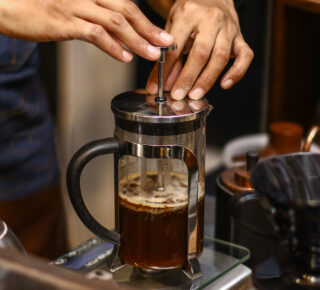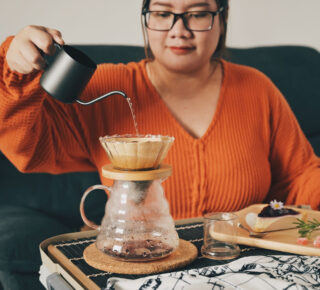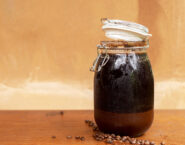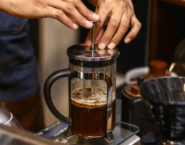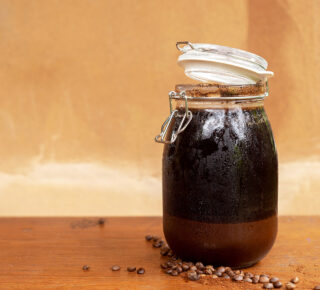
Simply put, “drip coffee” is what many people think of when they think of coffee. It’s probably the most common starting point for people learning how to make coffee.
Drip coffee is brewed using an automatic drip brewing machine that slowly drips hot water over ground coffee beans in a filter, extracting the flavors as it passes through into a glass pot or carafe.
This brewing method is popular in the U.S. because it’s convenient and makes consistent, bright-tasting coffee. The machine does most of the work, and there are a wide range of drip coffee makers available, including many affordable options.
Sippable fact
Drip coffee vs pour-over—ever wondered what the difference is? Both methods involve pouring hot water through coffee grounds in a filter. However, while drip coffee is made by an automatic machine, you make pour-over coffee by hand-pouring the water.
While the methods are similar for drip vs pour-over coffee, they do have different advantages. Drip coffee is simple and convenient, and you can make a larger batch at one time with many drip coffee makers. Because the machines are automatic, they control the brewing process, which means you get a consistent cup each time—but you don’t have as much ability to customize. Pour-over coffee can be more flavorful and is customizable, as you can fine-tune it to your taste. However, this method may only make one cup of coffee at a time, depending on the brewer, and because it’s a manual process, it requires more skill.
Here’s how to make drip coffee so that you get the best freshness and flavor—with tweaks that can help you find your perfect cup.
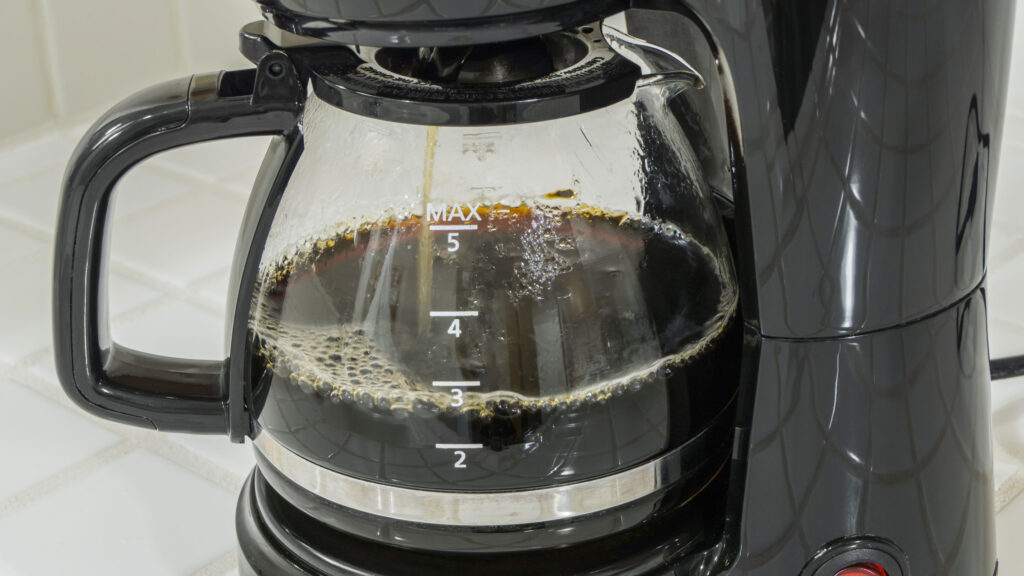
Equipment
To make drip coffee, you will need:
- Automatic drip coffee maker
- Filters (unless the coffee maker comes with a built-in filter basket)
- Grinder (optional, but preferred)
Automatic drip coffee makers
There is an automatic drip coffee maker out there for every household. It’s just a matter of what your needs and priorities are! One of the first things to consider is the shape of the machine’s filter basket, which is integral to the brewing process and can contribute to how your coffee will taste (along with other factors like the variety, origin, and roast of your coffee beans).
Flat bottom
A flat bottom filter basket is wider than a cone filter basket, so it has a larger surface area. Water flows through more quickly, which can result in a smoother, milder flavor.
Cone
A cone filter basket concentrates the water flow over a smaller surface area, slowing it down. This process can result in a richer and more complex flavor.
As you’re looking, here are a few other key factors to keep in mind—and questions to ask yourself.
- Cost: What’s your price range for your coffee maker? Consider additional costs as well, such as any accessories you might want to buy, coffee filters that will need to be replenished, etc.
- Size: What will fit in the space you have?
- Capacity: How many cups of coffee do you need to make at one time?
- Programming and features: The most highly sought-after feature is probably the ability to program your coffee maker to brew on a timer—but what else do you need it to do?
- Safety: If you pick a coffee maker loaded up on features, does it have all the safety measures you want—such as automatic shut-off to prevent overheating?
- Design: What fits your aesthetic and the style of your kitchen?
- Cleaning and maintenance: The more bells and whistles, the more maintenance is probably required—what are you willing to do to keep your coffee maker clean and in good order?
- Noise: If you’re sensitive to noise—or want to avoid disturbing others—how much noise is acceptable for you?
- Customer reviews and ratings: There’s nothing like hearing from others who have used a coffee maker—what are they saying about your top choices?
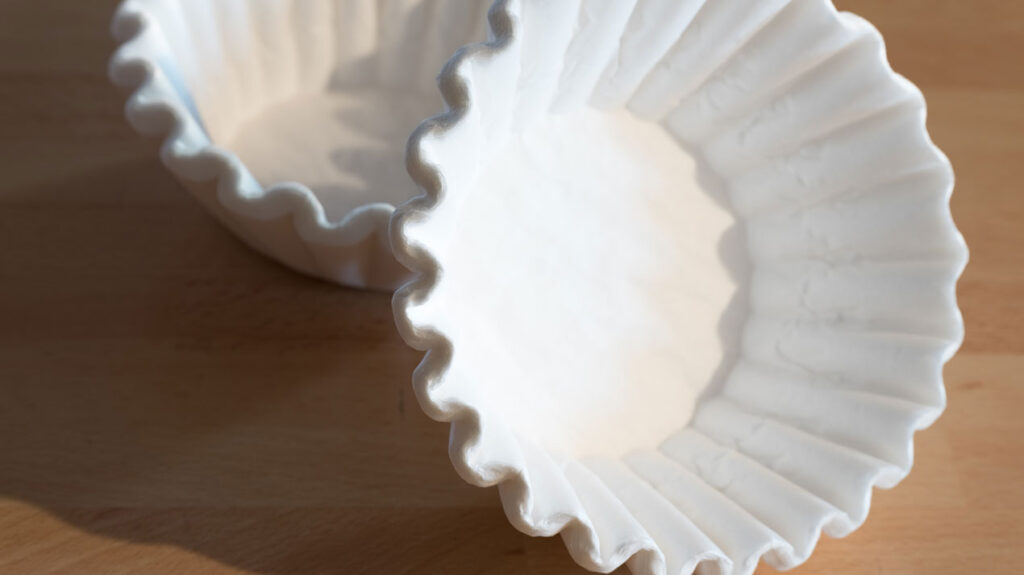
Filters
If your drip coffee maker doesn’t come with a reusable filter, you’ll need to provide a filter. As with any brewing method, you’ll need to check the instructions for your coffee brewer to see exactly what types of filters it can support. The most common coffee filter materials are paper, metal, and cloth—while each has its merits, most people use paper filters with drip coffee makers.
Paper filters
Generally, paper filters absorb more of the oils in coffee, which can contribute to a cleaner, lighter taste. If you want to experiment with paper filters, you can try out different thicknesses, materials, and densities (how closely the fibers are knitted together) to see what works best with your preferred coffee and flavors. While many paper filters are disposable, there are also more environmentally friendly options like compostable and biodegradable paper filters available.
One of the biggest debates in the coffee-loving world is whether to use bleached or unbleached paper filters. Bleached paper filters are whitened, like most paper we use, while unbleached filters are not, requiring less processing. Unbleached paper filters are therefore considered by many to be slightly better for the environment—but they can create an unpleasant, papery taste. (Some bleached paper filters may leave a similar taste, to be fair). It’s an easy fix, however: just rinse any paper filter before brewing.
Metal filters
Some drip coffee makers support metal filters, which are often made of a stainless steel mesh. They allow more oil and sediments to flow into the brewed coffee, which can result in a more intense taste and texture in your cup. While metal filters cost more as an initial purchase, they save you the cost of restocking your paper filters over time—and create environmental benefits as a reusable option. Metal filters do need to be cleaned thoroughly to remove any lingering residual flavors or oils that can negatively impact the taste of future brews.
No matter what type of filter you use, be sure it’s the right size for your coffee maker. If the filter bunches up (especially flat-bottom paper or cloth filters), it can trap coffee grounds and prevent the water from flowing evenly.
Grinders
While you can buy and use ground coffee, buying whole coffee beans and grinding them immediately before brewing guarantees maximum freshness.
There are two types of grinders: burr (or mill) grinders and blade grinders. We recommend using a burr grinder—whether at home or where you buy your coffee beans.
Burr grinders
A burr grinder crushes coffee beans between a moving grinding wheel and a non-moving surface (the two “burrs” in the name). These grinders do a better job of creating a consistent grind, which allows the flavors of the coffee to extract more evenly, and they’re better for the types of coffee that require smaller grind sizes, like espresso or French press. They’re also less likely to overheat the grounds during the grinding process, preserving the coffee’s oils and aromas.
Blade grinders
A blade grinder is less refined than a burr grinder, with a metal blade that spins to grind the beans. It functions a lot like a food processor, so how long you run the grinder determines how coarse or fine the grind is, though it’s not always easy to control. You can’t ensure a consistent grind, which impacts taste. However, you can get to know your grinder over time and determine the right length of grinding time for your preferred cup of coffee.
Whichever grinder you choose, always follow the manufacturer’s recommendations while using it, and be mindful of any necessary safety considerations.
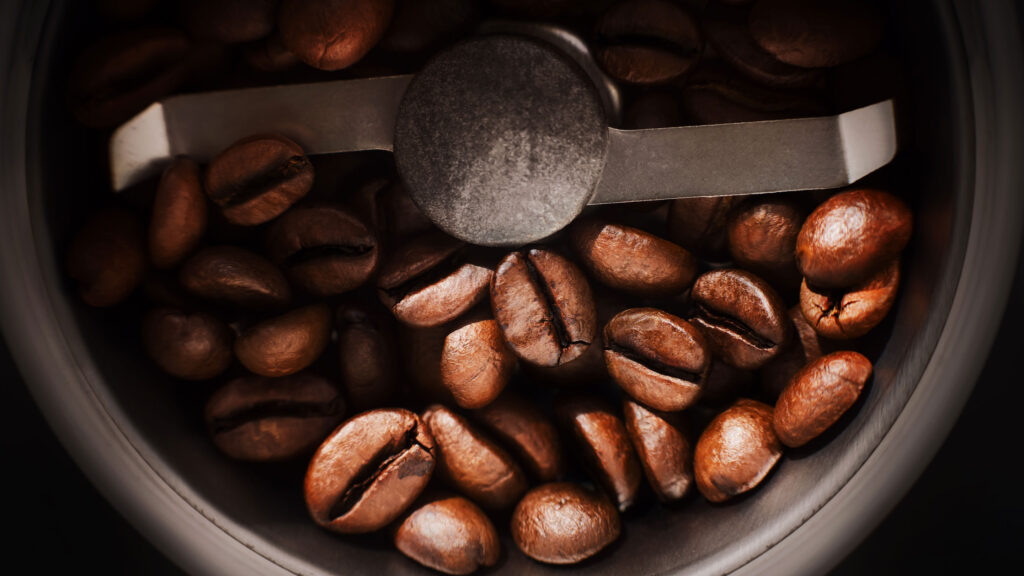
How to grind coffee beans
The size of your coffee grind has a significant impact on the taste of your coffee. Knowing how to grind coffee beans starts with your brewing method. If you’re having your coffee ground where you buy it, just decide in advance how you plan to brew it.
As a general rule, the longer the coffee is in contact with water during the brewing process, the coarser the grind should be. That’s why espresso, which brews in seconds, requires a fine coffee grind, while cold brew, which can take hours to prepare, typically requires a coarse grind.
Pick your drip coffee grind size
To find the best drip coffee grind size, start with a medium grind, then adjust as needed to brew your perfect cup.
| Brewing Method | Size of Coffee Grind |
|---|---|
| French press | Coarse (like rock salt) |
| Cold brew | Coarse |
| Drip | Medium (like kosher salt) |
| Pour-over | Medium |
| Espresso | Fine (like table salt) |
Coffee grind size and taste
If you’re not getting the taste you prefer—or if you just want to experiment with your coffee grind—try adjusting in one of two ways.
- Your coffee tastes bitter or sour: it may be ground too fine (over-extracted), so try a larger, coarser grind.
- Your coffee tastes flat or watery: it may be ground too coarse (under-extracted), so try a smaller, finer grind.
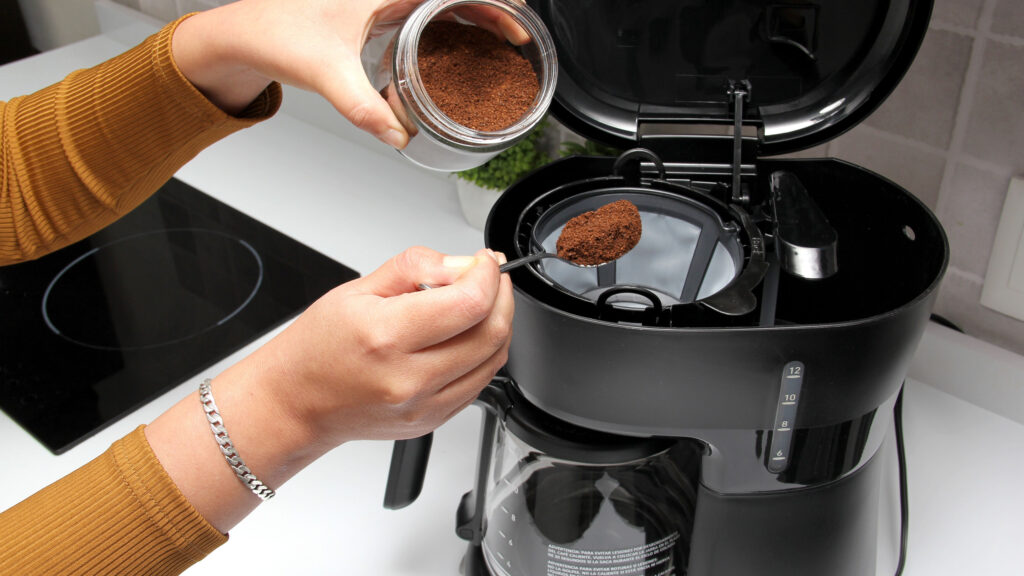
How to make drip coffee
One of the benefits of drip coffee is that it’s very simple—once you’ve chosen a coffee maker, it handles most of the process. The trade-off is that you don’t have as much control over the brewing itself. However, you can control what goes in the coffee maker. There are three consistent elements of how to make coffee you’ll love:
Sippable Fact
For drip coffee, here are the quick numbers you need to know:
• Coffee-to-water ratio: 1 to 2 tablespoons of ground coffee for every 6 ounces of water (the “Golden Ratio”)
• Brewing time: 5 minutes, approximately, of contact between coffee and water
Step-by-step guide: How to make drip coffee
While each drip coffee maker is a little different, here are the general steps you follow to make drip coffee.
- Fill the reservoir with water.
- Place your filter in the brewing basket.
- Add your ground coffee into the filter.
- Turn on the machine and wait for the brew cycle to complete.
- Enjoy! (And don’t forget to recycle those used coffee grounds.)
How to clean a drip coffee maker
It’s important to clean your equipment and tools after each use, following the instructions specific to your machine.
In terms of how to clean a drip coffee maker, be sure to at least rinse your brewing basket and filter (if permanent) after each use with clear, hot water—or wipe them down thoroughly. Then, dry with an absorbent towel. Periodically, you should wash these parts with hot, soapy water—or you can do this after each use, if you prefer. It’s important to check that no grounds have been left to collect and that there’s no build-up of coffee oil (caffeol), which can make future cups of coffee taste bitter. You should wash your coffee pot or carafe after each use as you would your coffee mug.
Many drip coffee makers have a hot plate to keep the coffee warm, and if yours does, be sure to wipe off any spilled coffee after each use (once the hot plate has cooled, of course). If you get one of those pesky burned coffee stains, try rubbing with a damp sponge and baking soda.
Finally, if your coffee maker has an external water filter, be sure you follow the manufacturer’s instructions for cleaning and/or replacing the filter as needed.
Descaling your drip coffee maker
Over time, the minerals in your home’s water can build up in your coffee maker—especially if you use tap water to make coffee. The process to remove these minerals is called descaling, and major manufacturers recommend descaling your coffee maker at least every 3-6 months.
Descaling can be done differently for different types of coffee makers—check your instructions for the most reliable way to descale without causing harm to your machine. For some, a solution of white vinegar and water will work, and you can find detailed instructions for this process online. Just be sure to rinse by brewing several cycles of plain water to remove any lingering vinegar taste!
For other coffee makers, the manufacturer may make a specialized descaling solution. There are also options out there for specific circumstances, such as solutions tailored to hard water sources and all-natural solutions. Just read your machine’s instructions and research to find what works best for you.
Feel like you’ve got the hang of drip coffee? Check out other coffee brewing methods like pour-over, espresso, French press, and cold brew.
Safety should always be a top priority when preparing, serving, or drinking any hot beverage—please take all necessary precautions! Be sure to follow all the specific instructions for use, cleaning, storage, and maintenance provided with your brewing equipment and tools (including but not limited to brewing machines and devices, grinders, kettles, scales, and filters). Be mindful of how hot liquids and equipment may get during the brewing process, and if you grind your coffee beans, be particularly careful with the sharp blades.

